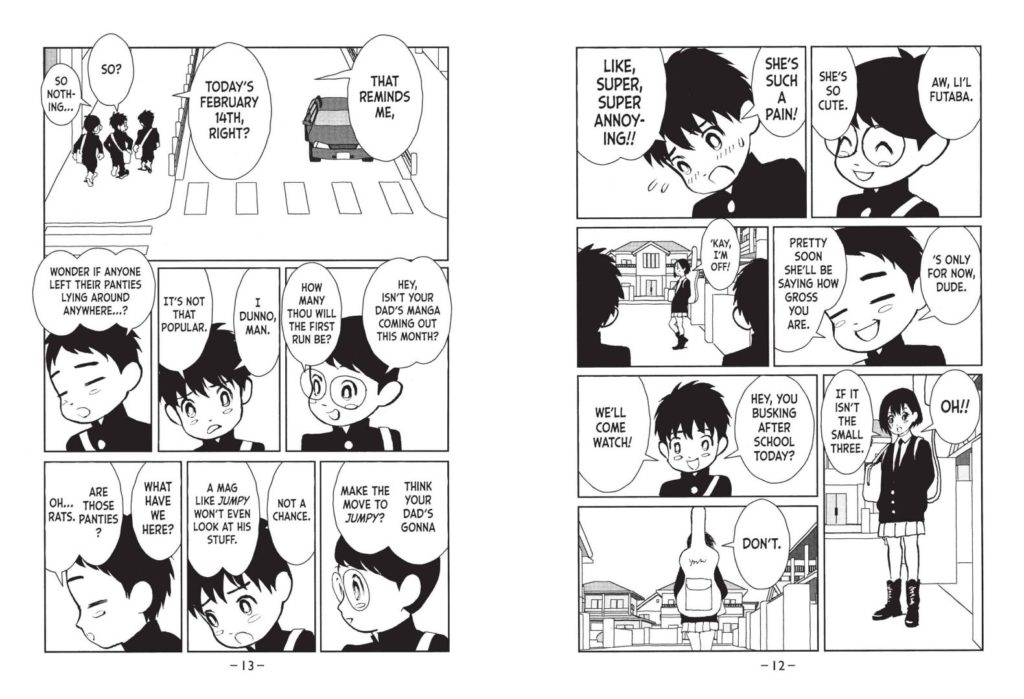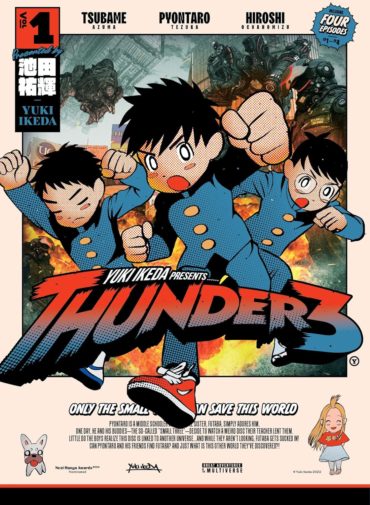Thunder 3 Volume 1 Review
Isekai can at times be a confusing genre of manga, and indeed the sub-genres that occur when you break it down even further. Manga fans know that most isekai involve someone travelling to another world, and reverse isekai feature someone from another world landing in our realm. What is it then, when some people who look cartoonish but appear to live in a normal world, travel to a very realistic world but with some sci-fi twinges to it?
This series revolves around the adventures of three schoolboys and neighbours known as the Small Three: Pynotaro Tezuka, Tsubame Azuma and Hiroshi Ochanomizu. One day, they visit their teacher who lends them a disc for a PS5 (he only has older consoles) which he says links to another world. Pynotaro tries the disc out in his house, and the image displayed is one of a lush park. The appearance of this landscape is in stark contrast to their own world. The boys themselves live in what we would consider to be a cartoon-like world, with the humans having a chibi quality to them. The world on the screen looks much more like our own world.

Thunder 3 © Yuri Ikeda/Kodansha Ltd.
While the boys are away, Pynotaro’s younger sister Futaba see an insect fly out of the screen, maintaining its realistic appearance. She in turn climbs into the TV screen and wanders around the realistic world, but maintaining her cartoonish look. When she bumps into the people of this world, they all take photos of her because they think she is an anime character come to life.

Thunder 3 © Yuri Ikeda/Kodansha Ltd.
One of the people taking photos is much taller than the rest, and indeed doesn’t look human. When Futaba looks upwards, she sees a gigantic spacecraft in the sky. The craft attacks, making a noise that alerts the Small Three, who go inside the TV to investigate. There, Pynotaro witnesses Futaba being taken away by the craft’s occupants. He gives chase, grabbing onto the craft as it takes to the skies again, but falls off, seemingly to his death.

Thunder 3 © Yuri Ikeda/Kodansha Ltd.
But Pynotaro doesn’t die. He crashes into the ground completely unhurt. He, Tsubame and Hiroshi discover that in this world, their bodies are incredibly strong, so they can run fast, jump huge heights and survive all manner of attacks. Pynotaro is determined to get Futaba back, so they stay in this new world. They learn that in structure, the layout of this world is the same as their own, so they go to their own houses and encounter their parallel selves, staying as their alternative, realistic counter parts. During this time they learn that five months ago, this world was visited by a race of aliens who occupy the craft. They say they have come in peace, but not everyone trusts them and soon enough, the Small Three encounter problems with these alien visitors.
Undoubtedly the most intriguing aspect of Thunder 3 is the artwork, namely the stark contrast between the chibi-like appearance of the central characters, and the realistic world in which they find themselves sucked into. It feels like if a character from a series like Doraemon ended up meeting characters from Gantz, in the world of Dead Dead Demon’s Dededede Destruction – and given that the last of these also features alien spaceships hanging in the sky resulting in an uneasy relationship between aliens and humanity, the comparison seems fitting. (Indeed, it appears that some Japanese writers have made similar comparisons, which I was unaware of until I came across it in the Wikipedia article for the series.) One imagines what it would be like trying to animate such a manga. Would you need a large team trying to deal with all these sorts of artistic styles? Perhaps a Who Framed Roger Rabbit? style of mixing animation and live-action would be more fitting.
Regarding the writing, for the most part it seems like standard isekai material. Much of this first volume appears to consist of world-building and we don’t really get into anything deeper until the end of this first volume. Probably the best moments are when we see Futaba on the ship, where the aliens try to experiment on her, but her cartoonish body makes it impossible. She, like her fellow travellers, has a stronger body compared to everyone else, so when she hits the wall of the room she is in, she easily knocks it down, to the comic panic of the aliens. Another humorous moment occurs when the boys try to buy some train tickets with what looks like cartoon money in our world, so in order to make some cash they have to busk and sing songs to the realistic people, who adore the appearance of anime characters performing.
As for the production of the manga, translation is done by Cat Anderson, and the manga is edited by Daniel Joseph. The work is translated well, including an up-to-date yen-to-dollar conversion rate. The book is presented in a cover with what feels like a matte finish, so it is pleasant to hold, too. No letterer is credited in the book, but the lettering should be highlighted, particular with the use of an otherworldly font that is used when the aliens speak. It does set the tone well, although it is a bit harder to read than the rest of the text.
Overall, it is hard to say what Thunder 3 feels like at this early stage. With most of the plot taken up with explaining the premise of the story, we can’t really tell how good or bad it is until we read deeper. However, the contrasting styles of artwork do mean that you should at least get something a bit more unique that most isekai stories.
Read a free preview on the publisher’s website here.
Our review copy from Vertical was supplied by Turnaround Publisher Services.


